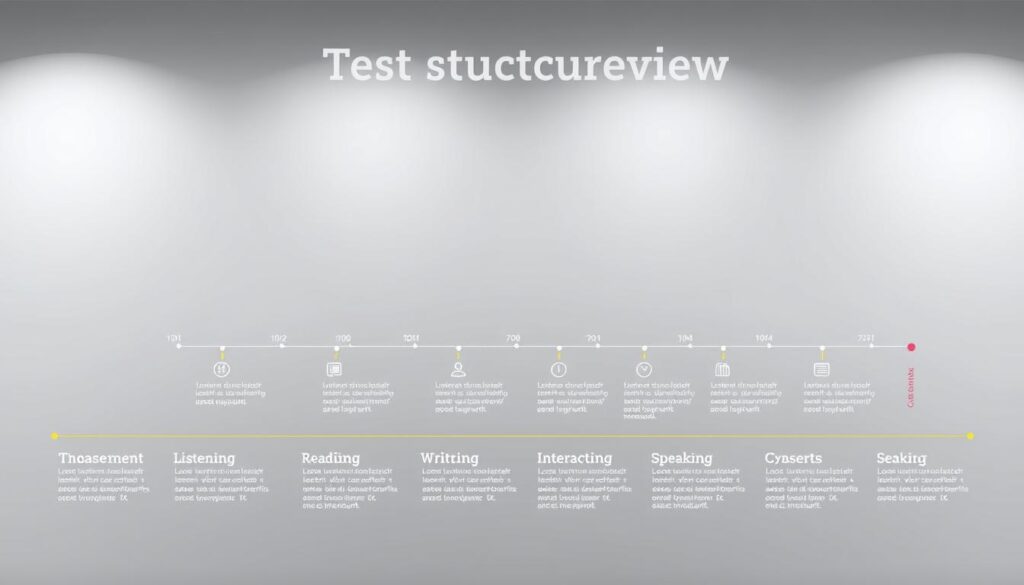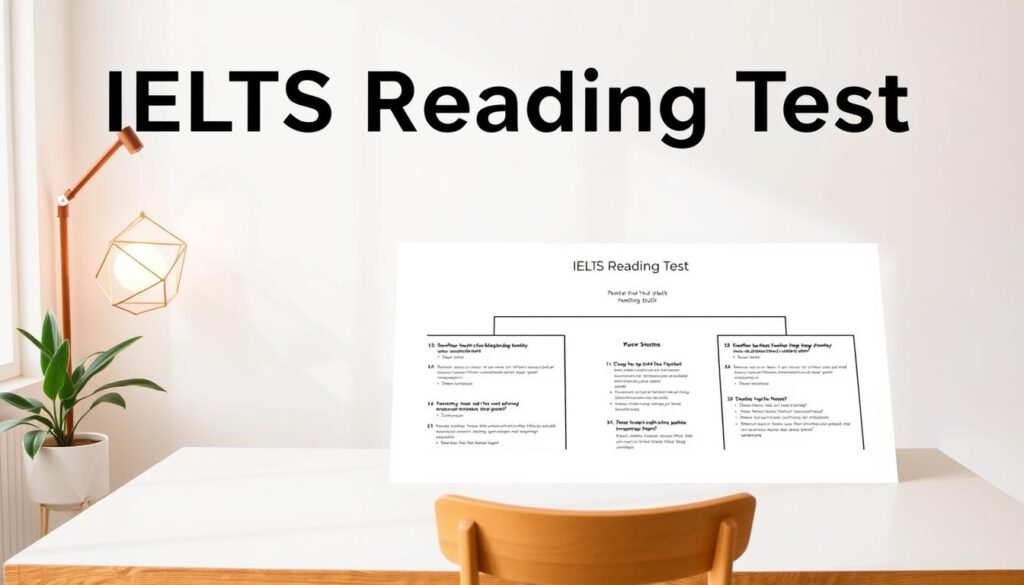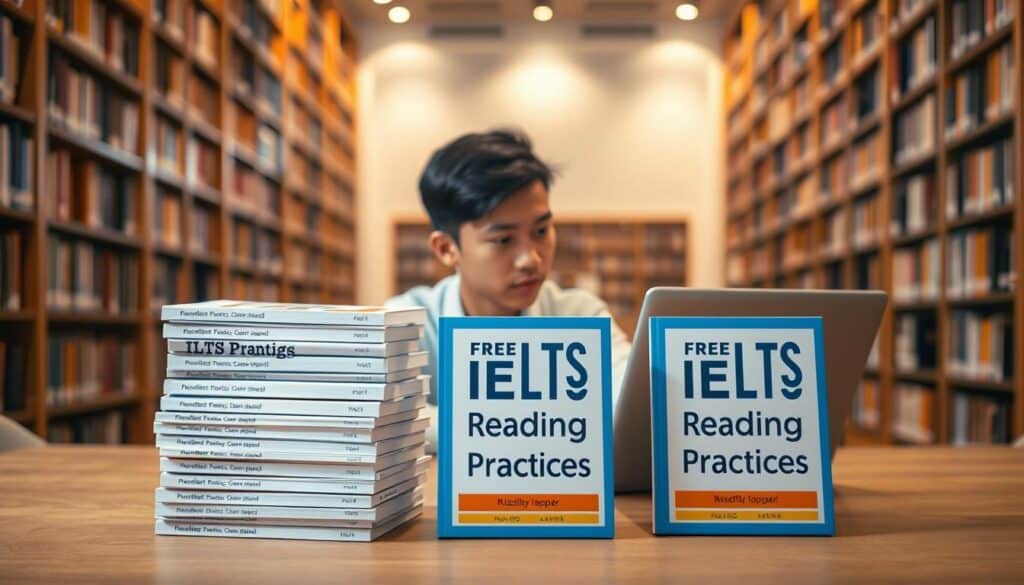Welcome to your comprehensive guide to excelling in the IELTS Reading test! This section is designed to help you understand the structure, question types, and strategies needed to achieve a high score.
The IELTS Reading test is a 60-minute section that includes 40 questions divided into three parts. These parts assess a variety of skills, such as reading for gist, main ideas, and specific details. Understanding the test format is crucial for effective time management and maximizing your score.
This guide will cover everything from question types to expert tips, ensuring you’re well-prepared for your exam. Whether you’re aiming for Band 7 or higher, the strategies and practice advice here will help you succeed.
Key Takeaways
- The IELTS Reading test lasts 60 minutes and includes 40 questions.
- It assesses skills like skimming, scanning, and understanding specific details.
- Understanding the test format is key to effective time management.
- Practicing with official materials can improve your performance.
- Focusing on vocabulary and reading speed can enhance your results.
Introduction to IELTS Reading
Discover the essential elements of the IELTS Reading test and how it evaluates your abilities. This section will guide you through the fundamental aspects and significance of this test component.
Understanding the Basics
The IELTS Reading test is a 60-minute session containing 40 questions. These questions are divided into three sections, each designed to assess different reading skills. Candidates must skimming for main ideas, scanning for specific details, and engaging in detailed reading to comprehend complex texts. Understanding the test structure is vital for effective time management, ensuring you can answer all questions within the allotted time.
Importance for Test Takers
Every question counts, as each correct answer contributes to your final score. Consistent practice is key to building confidence and improving your comprehension. A strong foundation in these skills supports advanced strategies discussed later in this guide. For more practice materials, visit our resource page to enhance your preparation.
Understanding Test Format and Structure
The IELTS Reading test is divided into three sections, each with unique characteristics and challenges. This structure helps assess a wide range of reading skills, from skimming to detailed comprehension. Understanding each section’s format and timing is crucial for effective test preparation.
Overview of Sections and Timing
Candidates have 60 minutes to complete all three sections, with each section containing 10-15 questions. The test is designed to gradually increase in difficulty, starting with simpler texts and progressing to more complex ones. This progression requires strategic time management to ensure all sections are completed within the allotted time.
Here’s a breakdown of the sections and recommended time allocation:
| Section | Content | Recommended Time |
|---|---|---|
| 1 | Short, factual texts | 15 minutes |
| 2 | Descriptive or analytical texts | 20 minutes |
| 3 | Long, complex texts | 25 minutes |
As the sections progress, the texts become longer and more complex, requiring more time and attention. Managing your time effectively is key to answering all questions accurately.
Reading the instructions carefully before starting each section ensures you understand what is being asked. This helps in answering questions more accurately and efficiently. The organization of the test influences your overall performance, so understanding the structure is vital for success.
Skills Assessed in IELTS Reading
Academic reading tests evaluate a range of skills to ensure candidates can process information efficiently. These skills are vital for academic success and daily tasks.
Skimming and Scanning Techniques
Skimming involves quickly reading a text to grasp the main idea. For example, reading the introduction and conclusion to understand the author’s stance. Scanning is about finding specific details, like dates or names, by focusing on key sections. Both techniques are essential for managing time effectively during the test.
Detailed Reading and Inference Skills
Detailed reading requires understanding complex texts to identify main ideas and supporting details. Inference skills involve drawing conclusions based on the information provided. For instance, understanding the author’s tone or implicit messages enhances comprehension.
| Skill | Technique | Importance |
|---|---|---|
| Skim | Quickly identify main ideas | Time management |
| Scan | Find specific details | Accuracy |
| Detailed Reading | Analyze complex texts | Comprehension |
Practicing these skills with sample materials improves efficiency. Understanding question types enhances test performance. Regular reading strengthens overall ability, making it easier to handle academic texts and real-life documents.
What is IELTS Reading
The IELTS Reading test is a critical component of the exam, designed to assess your ability to understand and interpret written English. It is divided into three sections, each targeting different reading skills such as skimming, scanning, and detailed comprehension. This section is crucial for both academic and general training candidates, as it evaluates how well you can process information from various texts.
Key Features of the Test:
- 40 Questions divided into three sections.
- 60 Minutes to complete the entire test.
- Academic vs. General Training: Academic focuses on complex texts, while General Training includes everyday and workplace materials.
Your final score is based on the number of correct answers, with each question worth one mark. Regular practice is essential to improve your reading speed and comprehension. Understanding the structure of each section helps in managing time effectively and achieving a higher score.
Visit our resource page for practice materials to enhance your preparation.
Breaking Down Academic vs General Training Reading
Understanding the differences between the Academic and General Training Reading tests is crucial for effective preparation. Each test is designed for distinct purposes, catering to different needs and contexts.
Academic Reading Overview
The Academic Reading test is tailored for individuals planning to study in English-speaking countries. It focuses on complex texts, such as academic journals, research articles, and books. These materials are similar to what students encounter in a university setting. For example, you might read about scientific studies or historical analyses, requiring detailed comprehension and analytical skills. Time management is key here, as the texts are lengthy and dense.
General Training Reading Overview
In contrast, the General Training Reading test targets everyday English skills. It includes texts related to workplace scenarios, social interactions, and practical information. For instance, you might read employee handbooks, news articles, or public announcements. These materials are more conversational and varied in length, requiring quick scanning and skimming to extract necessary details. Time strategies here focus on efficiency, given the diverse range of topics.
Both tests assess reading skills but in different contexts. Academic Reading emphasizes complex, formal texts, while General Training focuses on practical, everyday materials. Recognizing which test you need early on helps tailor your preparation effectively, ensuring you’re well-equipped for the specific challenges each presents.
Exploring IELTS Reading Question Types
The IELTS Reading test features a diverse range of question types designed to assess different comprehension skills. Each question type requires a unique approach to ensure accuracy and efficiency. Understanding these formats is key to maximizing your score.
Multiple Choice and Matching Headings
Multiple-choice questions present several options, and you must select the correct answer. Skim the passage to identify the main idea before reading the question. For matching headings, match each paragraph with the most appropriate heading. This requires a quick skim of each paragraph to grasp its focus.
Sentence, Summary, and Table Completions
Sentence completions test your ability to fill in gaps with the correct word or phrase. Focus on the context around the gap to determine the right answer. Summary completions involve filling in a summary with missing words, requiring you to identify key points. Table completions are similar but organized in a table format, often based on specific data from the text.
- Skim the passage to grasp the main idea before tackling questions.
- Scan for specific details when answering multiple-choice or matching questions.
- Use the process of elimination to narrow down options in multiple-choice questions.
- Practice under timed conditions to simulate real test scenarios.
Regular practice with various question types will enhance your reading skills and boost your confidence. Timed practice tests help you get used to the pressure of the actual exam. Understanding each question type’s structure allows you to approach them methodically, ensuring you make the most of your time and achieve a higher score.
Effective Time Management Strategies
Managing your time wisely is crucial for success in the IELTS Reading test. With 40 questions to answer in 60 minutes, every second counts. Here’s how you can make the most of your time.
A well-planned strategy starts with dividing your time equally across the three sections. Allocate 20 minutes to each section, ensuring you have enough time to tackle all questions without rushing. This balanced approach helps maintain focus and accuracy.
| Section | Time Allocation | Focus |
|---|---|---|
| 1 | 20 minutes | Quickly skim for main ideas |
| 2 | 20 minutes | Scan for specific details |
| 3 | 20 minutes | Analyze complex texts thoroughly |
Identify easier sections to complete faster, allowing more time for challenging questions. For example, if Section 1 has straightforward questions, spend less time there and allocate the saved time to Section 3, which may have complex texts.
“Time management is the cornerstone of a high score. Practice under timed conditions to build speed and confidence.”
Regular practice with timed tests simulates real test conditions, helping you adapt to the pressure. Set a pacing plan before test day to ensure you stick to your strategy. Proper timing prevents rushed decisions, leading to more accurate answers and a higher score.
By mastering these strategies, you’ll approach the test with confidence, ensuring you maximize your score. Remember, effective time management is your key to success in the IELTS Reading test.
Techniques to Improve Reading Speed and Accuracy
Mastering the art of reading efficiently is key to excelling in any exam. When it comes to the IELTS Reading test, improving your reading speed and accuracy can significantly boost your score. This section shares proven techniques to help you read smarter, not harder.
Developing Rapid Reading Skills
One effective method is word chunking. By reading 3-5 words at a time, you can increase your reading efficiency. This technique reduces subvocalization, allowing you to process information faster. Regular practice with sample materials can enhance your speed by up to 50%, making it easier to handle complex texts during the test.
Practicing with Timed Tests
Simulating real test conditions is crucial. Set a timer and practice reading passages within the allotted time. This helps you manage your time effectively and build confidence. For example, allocate 15 minutes to skimming and 25 minutes to detailed reading, ensuring you cover all sections without rushing.
| Technique | Benefit | Application |
|---|---|---|
| Word Chunking | Increases reading speed | Read 3-5 words at a time |
| Skimming | Saves time | Focus on main ideas quickly |
| Scanning | Enhances accuracy | Locate specific details fast |
By combining these techniques, you can achieve a balance between speed and comprehension. Regular self-assessment and timed practice will help you track your progress and identify areas for improvement. Remember, consistent practice is key to mastering these skills and securing a high score.
Leveraging Free IELTS Reading Practice Tests
Enhancing your reading skills for the IELTS test is easier than ever with free online practice tests. These resources simulate real exam conditions, helping you build confidence and familiarity with the test format.
Free practice tests offer multiple benefits. They let you practice various question types, like multiple-choice and matching headings, under timed conditions. This helps you get used to the test’s timing and structure, making you more efficient on exam day.
Online platforms provide sample passages and timed scenarios that mimic the actual test. For example, you can find tests that include academic texts like journal articles or general training materials like workplace documents. These resources help you understand the differences between academic and general training formats.
Regular practice helps identify your strengths and weaknesses. By reviewing your results, you can focus on areas where you need improvement. This targeted approach ensures you make the most of your study time.
| Test Type | Focus | Time |
|---|---|---|
| Academic | Complex texts, academic topics | 60 minutes |
| General Training | Everyday, workplace scenarios | 60 minutes |
As the saying goes, “Practice is the key to perfection.” Regular practice not only improves your reading speed and comprehension but also boosts your confidence. By incorporating these free resources into your study routine, you’ll be well-prepared for the IELTS test and more likely to achieve a high score.
Comprehensive Tips to Secure a High Band Score
Scoring high in the IELTS Reading test is achievable with the right strategies. Here’s how you can maximize your band score effectively.
Understanding Band Score Calculation: Your raw score is based on correct answers, converting to a band score from 0-9. Each question is worth one mark, making accuracy crucial. Even a few extra correct answers can boost your band score significantly.
| Tip | Strategy | Benefit |
|---|---|---|
| Skim and Scan | Skim passages for main ideas, scan for details | Saves time, improves accuracy |
| Match Headings Wisely | Preview headings before reading | Quickly identifies paragraph focus |
| Avoid Common Mistakes | Understand question types, manage time | Reduces errors, enhances efficiency |
Expert Recommendation: “Consistent practice and focused review are key to achieving a high band score. Understanding your weaknesses and addressing them is the most effective strategy.”
Regular practice with timed tests simulates real exam conditions, helping you adapt and improve. Focus on vocabulary and comprehension to tackle complex passages confidently. Remember, a systematic approach and efficient note-taking can make a significant difference in your performance.
Tailored Practice for American Students
American students often face unique challenges in the IELTS Reading test, particularly with cultural nuances and vocabulary. To bridge this gap, targeted strategies and localized resources can make a significant difference.
Addressing Common Challenges in the US Context
One major hurdle is the difference in cultural references. For example, British or Australian English terms might be unfamiliar to American test-takers. To overcome this, focus on practicing with region-specific materials that include American contexts.
Another challenge is vocabulary. American English often uses different terms for everyday items (e.g., “elevator” instead of “lift”). Regular practice with American English texts can help build familiarity with these differences.
| Tip | Strategy | Benefit |
|---|---|---|
| Skim and Scan | Skim passages for main ideas, scan for details | Saves time, improves accuracy |
| Use Flashcards | Focus on vocabulary building | Enhances retention of key words |
| Practice Timed Tests | Simulate real test conditions | Builds speed and confidence |
Recommended books like The Official Cambridge Guide to IELTS offer practice materials tailored to American English. These resources include passages and questions that reflect the cultural and linguistic nuances of American contexts.
By combining these strategies with regular practice, American students can effectively prepare for the test and achieve a high score. Understanding the test requirements and practicing with region-specific materials leads to improved performance and confidence.
Utilizing Online Resources and Expert Guidance
Unlock your full potential with expert-led online resources and comprehensive preparation materials. These tools are designed to provide in-depth insights and personalized guidance, helping you excel in your IELTS preparation journey.
IELTS Prep Bundles and Masterclasses
Online resources offer a wealth of benefits for IELTS test-takers. From interactive lessons to detailed study plans, these tools streamline your preparation process. For instance, comprehensive IELTS prep bundles provide structured materials that cover all aspects of the test, ensuring you don’t miss any crucial areas.
Expert masterclasses play a vital role in sharing insider tips and strategies. These sessions often include live interactions with IELTS instructors, offering personalized feedback and addressing specific weaknesses. Such guidance can significantly enhance your understanding and performance.
| Resource Type | Benefits | Recommended For |
|---|---|---|
| Prep Bundles | Structured materials, comprehensive coverage | Self-paced learners |
| Masterclasses | Expert insights, personalized feedback | Those needing targeted guidance |
| Study Plans | Organized schedule, focused learning | Test-takers with limited time |
For those preparing for the general training section, online resources can address both academic and everyday needs. Whether you’re focusing on complex texts or practical scenarios, these tools adapt to your specific requirements.
Visit our resource page for access to free IELTS Masterclasses and study plans. Regularly updated materials ensure you stay informed with the latest strategies and question types.
Continuous learning is key to achieving a high band score. By leveraging online support and expert guidance, you can efficiently address weaknesses and build confidence. Tailored resources help you focus on areas needing improvement, ensuring a well-rounded preparation.
Don’t miss out on the opportunity to elevate your preparation. Explore the wealth of online resources and expert guidance available, and take a significant step toward securing the score you deserve.
Understanding IELTS Reading Band Score Calculation
Your IELTS Reading band score is calculated based on the number of correct answers you provide. Each question is worth one mark, and the total is converted to a band score ranging from 0 to 9. Incorrect or unanswered questions do not deduct marks but can impact your score by not contributing to your total.
The impact of each correct answer is significant. For example, achieving 30 correct answers can push you from a Band 6 to a Band 7. This demonstrates how even small improvements can lead to a higher band score. Understanding this scoring system helps set realistic goals and prioritize study focus.
Practical advice includes monitoring your progress by tracking correct answers and estimating potential scores. This allows you to adjust your study strategies effectively, ensuring efficient use of your time. By focusing on tasks that influence the score the most, you can enhance your performance and achieve your desired band.
Step-by-Step Guide to Analyzing Passages
Mastering the skill of passage analysis is essential for excelling in the IELTS Reading test. This section provides a systematic approach to breaking down complex texts, ensuring you can extract information efficiently and effectively. Whether tackling multiple-choice questions or identifying main ideas, these strategies will enhance your performance.
Parsing Complex Texts
Begin by skimming the passage to grasp the overall context. Focus on headings, subheadings, and the first sentences of each paragraph to identify the main theme. For instance, in a multiple-choice question, understanding the passage’s structure can help you eliminate incorrect options quickly.
Next, scan for specific details. Look for names, dates, or key terms that relate to the question. This technique is particularly useful for multiple-choice questions, as it allows you to pinpoint relevant information without reading the entire text.
Identifying Main Ideas and Supporting Details
Once you’ve identified the main theme, break down the passage into smaller sections. Look for topic sentences that summarize each paragraph’s main idea. Supporting details will elaborate on these ideas, providing evidence or examples.
- Identify the main idea by skimming headings and topic sentences.
- Locate supporting details that elaborate on the main idea.
- Use these details to answer specific questions, especially in multiple-choice formats.
Practicing these techniques with sample passages will improve your speed and accuracy. Regular timed exercises can simulate real test conditions, helping you manage your time effectively and build confidence. By systematically reviewing passages, you’ll enhance your ability to extract key information and achieve a higher score in the IELTS Reading test.
Advanced Strategies for Matching Information Questions
Mastering matching information questions requires a deep understanding of how ideas are presented in a text. These questions test your ability to quickly locate and match details from the passage to the correct options. The key is to identify the underlying idea behind each question and use it to pinpoint the correct answer.
To succeed, focus on comparing text segments and matching them to the most appropriate option. Pay close attention to subtle clues in the text that can lead you to the correct answer. For example, names, dates, or specific terms often serve as indicators for matching information effectively.
| Strategy | Technique | Benefit |
|---|---|---|
| Skim and Scan | Skim for main ideas, scan for details | Saves time, improves accuracy |
| Identify Key Terms | Look for names, dates, and specific terms | Facilitates quick information retrieval |
| Understand Synonyms | Recognize variations in wording | Enhances comprehension of complex texts |
Common pitfalls include mismatching information due to similar-sounding options. To avoid this, read the first and last lines of each paragraph to grasp the main idea. Practice tests are essential for mastering these strategies and building confidence. Proficiency in matching information can significantly boost your overall performance and help you achieve a higher score.
Conclusion
As you conclude this journey through the IELTS Reading guide, remember that mastery comes with consistent practice and detailed analysis. The strategies outlined here—from skimming and scanning to time management—are your tools to success. Each correct answer marks a step closer to your goal, and understanding the test format is key to maximizing your score.
Embrace free practice tests and online resources to refine your skills. Regular practice under timed conditions will build your speed and confidence. Remember, even small improvements can elevate your band score significantly. Stay focused, and let your preparation lead you to triumph on test day.
With dedication and the right approach, you’ll unlock your full potential. Make every practice count, and step into the exam with confidence. Your success is just a well-prepared step away!
FAQ
How do I improve my IELTS Reading score?
Focus on skimming, scanning, and practicing with timed tests. Regular practice helps build speed and accuracy.
What’s the difference between Academic and General Training Reading?
Academic focuses on academic texts, while General Training uses everyday topics. Both test reading skills but differ in content.
How are IELTS Reading band scores calculated?
Scores are based on correct answers out of 40 questions. Each question is worth one point, converted to a band score from 0-9.
How can I manage my time during the test?
Allocate time per section and question. Spend 1-2 minutes per question, leaving time to review.
What’s the best way to practice IELTS Reading?
Use official practice materials and take timed tests to simulate exam conditions and improve speed.
What are common mistakes in IELTS Reading?
Not identifying main ideas and mismanaging time. Focus on key points and allocate time wisely.
How can I handle complex texts?
Break texts into main ideas and supporting details. Use headings and keywords to guide your reading.
What’s the best strategy for multiple-choice questions?
Read the question first, eliminate wrong options, and use context clues to find the answer.











